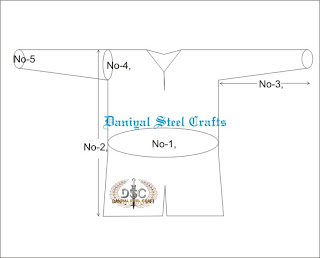Daniyal Steel Crafts
Decimus Statilius Crescens
Chain Mail, Chain Maille is a type of Amour, consisting of small metal rings linked together in a pattern to form a mesh. Mail Amour provided an effective defense against the weapons, warded off the blow or thrust by a sword, pilum or spear, preventing the damage to the body, fracture or a bruise was an exception.
The word chainmail is of relatively recent coinage, having been in use only since the 1700s; prior to this it was referred to simply as mail. "mail", "mayle" or chain was the English name for it, while maille was the common French name for it. This—and the alternative spellings "maile" and "maille" - derive through the Italian maglia, from the Latin macula, meaning "mesh of a net". Spanish corresponding word is malla and Portuguese malha. Cymric term lluric refers to Latin lorica.
Mail was invented some time in the mid 1st milennium BC 1st millennium, but it is unknown where and by whom it was first used. The earliest finds are from 4th Century BC Celtic chieftain's burial located in Ciumeşti, Romania. It is believed that the Romans first came into contact with mail fighting the Gauls in. The Roman army adopted the technology for their troops in the form of the Lorica Hamata which was used as a primary form of armour through the Imperial period.
Several patterns of linking the rings together have been known since ancient times, with the most common being the 4-to-1 pattern (where each ring is linked with four others). In Europe, the 4-to-1 pattern was completely dominant.
Historically, in Europe, from the pre-Roman period on, the rings composing a piece of mail would be riveted closed to reduce the chance of the rings splitting open when subjected to a thrusting attack or a hit by an arrow.Up until the 14th century European mail was made of alternating rows of both riveted rings and solid rings. After that it was almost all made from riveted rings only.
Wire thickness is measured in milimeters.
Hauberk : Knee length and including sleeves (The sleeves sometimes only went to the elbow, but often were full arm length) Chain Mail Shirt. Slits to accommodate horseback-riding are often incorporated below the waist. Most are put on over the head. The word hauberk is derived from an old German word Halsberge, which originally described a small piece of mail that protects the throat and the neck. The earliest extant example was found in Ciumesti in modern Romania and is dated to the 4th-5th centuries BC. Roman armies adopted similar technology after encountering it. Mail armour spread throughout the world with the expansion of the Romans. The hauberk stored in the Prague Cathedral, dating from the 12th century, is one of the earliest surviving examples from Central Europe and was supposedly owned by Saint Wenceslaus. In Europe, use of mail hauberks continued up through the 14th century.
Haubergeon : Mid-thigh length Chain Mail Shirt.
Chausses : Chain Mail leggings. They could extend to the knee or cover the entire leg.
Coif : Chain Mail Hoods
Mitons : Chain Mail mittens.
Aventail / Camail : An aventail or camail is a flexible curtain of chainmail on a helmet, that extends to cover the neck and shoulders. The mail could be removed for cleaning or storage, and attached to the helm through use of a leather cord that was threaded through brass rings at the edge of the helm. Aventails were most commonly seen on bascinets in the 14th century and served as a replacement for a chainmail coif. Some aventails were decorated with edging in brass or bronze links, or dagged edges. By the late 15th century, the Aventail had replaced the chainmail coif completely. Only those who were poor or who were collectors of the sort had a chainmail coif. Aventails were typically attached to the helmet via small staples known as vervelles.
Pixane / Standard : Chain Mail Collar worn strapped around the neck, it drapes over the shoulders and covers the breast and upper back.
MATERIALS AVAILABLE
Mild Steel
Stainless Steel
Aluminum
Brass
P. V. C.






























